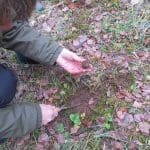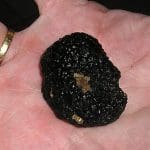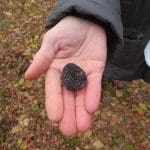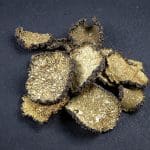Autumn Truffle / Autumn / Winter / Edible
Prepare to be seduced by the captivating allure of the Autumn Truffle, scientifically known as Tuber Uncinatum. In this blog post, we embark on a gourmet adventure, exploring the hidden treasures that lie beneath the forest floor.
With its earthy aroma and exquisite flavor, the Autumn Truffle has enchanted culinary enthusiasts for centuries, earning its place as a prized delicacy. Join us as we uncover the secrets of this culinary gem, from the art of foraging to the artistry of incorporating it into delectable dishes. Whether grated over pasta or infused into oils, the Autumn Truffle promises to elevate your dining experience to new heights. Let’s delve into the world of Tuber Uncinatum, where gastronomy and nature intertwine, and embrace the luxurious flavors that only the Autumn Truffle can offer.
Scientific Name
Tuber uncinatum
Common Names
Autumn Truffle, Burgundy truffle
Family
Tuberaceae
Habitat
They are mycorrhizal and grow just beneath the surface near oaks, birch, beech and hazel. They are more common in the south but they have been found as far north as the Peak District and Yorkshire.
Description
A delicious and much sought after fungus, they’re not as well-known as their continental cousins The Périgord Black (Tuber melanosporum) and The Italian Piedmont White (Tuber magnatum), but they are still a fantastic ingredients when you can find them.
Identifying Features:
Cap:
The roughly ball shaped, fruit bodies can be up to 10cm in diameter. Their skin or peridium is black and is covered in a network a pyramid shaped ‘warts’. Giving the whole body a rough bark-like texture. They lack a stem or gills, their spores are produced inside and are spread when animals eat and later deposit them. They are normally harvested between September and January.
Smell:
A nutty/mushroom type smell.
Spores:
Black to brown.
Uses
In food
They are much prized by chefs and have a lovely hazel nutty, fungal flavour. They’re less intense than a Périgord truffle which in my opinion is no bad thing.
As they are quite expensive, a good way to make the most of them is to store the truffle in a basket full of eggs. As the eggs shells are permeable the truffle flavour will transfer and makes the most amazing scrambled eggs.
After that they can be finely sliced or grated over savoury dishes or infused in oil to add a heady umami kick.
Notes on Herbal Uses
Truffles are general contain many important vitamins and nutrients including vitamin C, phosphorus, sodium, calcium, magnesium, manganese and iron.
They contain lycopene, gallic acid and homogentisic acid, which are important amino acids that studies show may lower your risk of conditions such as such as cancer, heart disease and diabetes.
They are also said to have aphrodisiac properties and have been used to boost fertile.
Known hazards
None known.
Potential lookalikes
The Summer Truffle (Tuber aestivum) was thought to be a separate species but modern DNA research has revealed that that are in fact he same species. Because chefs and the world of commerce does differentiate due to seasonality and price we do too.
You may see them labelled as Tuber aestivum subspecies aestivum for the summer variety and Tuber aestivum subspecies uncinatum for the Autumn truffle.
There is also the Yellow False Truffle (Rhizopogon luteolus).As the name suggest it looks like a truffle but they are paler in colour, have threads running into the ground at the base are normally appear above ground.
Extra Notes from the Foragers
Before you get too exciting about becoming a millionaire truffle hunter, they are a rare find for most.
They are normally under the surface and unless you have a trained pig or dog, you’re just hoping that they pop up above ground after a heavy rain.
Traditionally female pigs were used to hunt truffles, this is because truffles contain androstenol, a sex hormone found in the saliva of male pigs. (The same substance is in human sweat so that could be why they’re said to be an aphrodisiac) Pigs eat them if given half the chance, whereas dogs are more obedient so are used more nowadays.
I’ve read loads of articles and watched videos about hunting truffles without an animal but I don’t think its really worth the time and effort involved and in fact it may be damaging. You’re told to look for ‘brule’ or patches of ground that look burnt near suitable trees and then to dig around. I’ve never found any using this method and won’t do it again as I’m concerned about the potential damaged I’m causing the underground mycelium of other species.
That said I do know of a talented herbalist who can smell truffles. When he has selected a promising looking tree he gets down and smells the ground. He’s about 90% accurate but he has skills most of us will never have.
References:
https://www.bbcgoodfood.com/recipes/collection/truffle-recipes
https://www.healthline.com/nutrition/truffles










Leave a Reply
You must be logged in to post a comment.